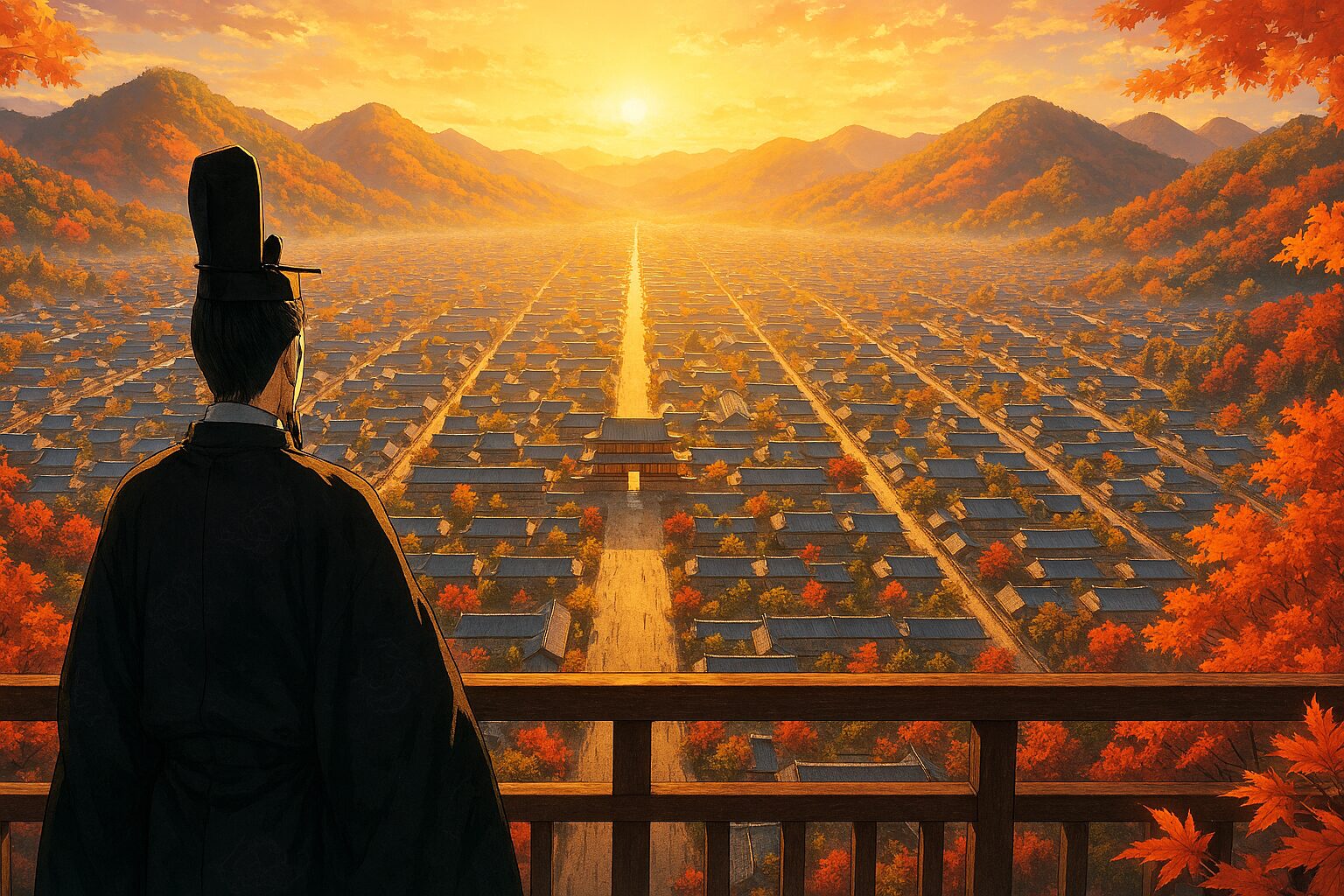Is there any other day in Japanese history filled with such beauty and desperate hope? On November 18, 794, Emperor Kammu, the 50th Emperor of Japan, moved the capital to a new location. The name of this new capital was “Heian-kyo” (Capital of Peace and Tranquility). This is what we now know as Kyoto.
This event was not merely a political relocation. It was a national prayer on a grand scale—a quest to escape curses, divine retribution, and political corruption in search of eternal peace. Today, we delve deep into the origins of Kyoto, the city that remained Japan’s capital for over a millennium.
The Nightmare of Nagaoka-kyo and the Vengeful Spirit
Just ten years prior to moving to Heian-kyo, Emperor Kammu had established a capital called “Nagaoka-kyo.” However, what awaited him there was an unimaginable series of misfortunes.
Famine caused by floods, rampant epidemics, and most feared of all, the presence of “Onryo” (vengeful spirits). It was believed that the spirit of Prince Sawara, the Emperor’s brother who had died after being falsely accused of a crime, was cursing the capital. The successive deaths of the Empress and the Crown Prince were all attributed to this vengeful spirit.
“If this continues, the nation will perish.” Convinced of this, Emperor Kammu sought the strongest spiritual land based on Feng Shui (Shijin-So-O). He looked for a perfect terrain guarded by the Genbu (Black Turtle) to the north, Seiryu (Azure Dragon) to the east, Suzaku (Vermilion Bird) to the south, and Byakko (White Tiger) to the west. That land was the Kyoto Basin.
A Perfect Grid City Modeled After Chang’an
The new capital, Heian-kyo, was designed modeling Chang’an, the capital of the Tang Dynasty (China), which was the global empire of the time. The city planning was a masterpiece of technology, with the Suzaku Avenue running north to south, dividing the city into Left Capital (East) and Right Capital (West) in an orderly grid pattern.
This orderly streetscape remains a defining characteristic of Kyoto’s geography today. The unique address system used in Kyoto, such as “Agaru” (going up/north), “Sagaru” (going down/south), and “Nishi-iru” (going west), is living proof that this 1,200-year-old urban plan is still active.
The Flowering of Japanese Sensibility in Heian-kyo
The relocation to Heian-kyo was also the greatest turning point in Japanese cultural history. Until then, Japan had been desperate to import and imitate culture from mainland China. However, with the establishment of the stable capital of Heian-kyo, the Japanese people began to cultivate a culture suited to their own climate and sensibilities.
National Culture and “Mono no Aware”
In the mid-Heian period, official missions to Tang China were abolished, and Japan’s unique “Kokufu Bunka” (National Culture) blossomed. The invention of “Hiragana” and “Katakana” from Kanji characters happened in this capital. Murasaki Shikibu wrote the world’s oldest novel, *The Tale of Genji*, and Sei Shonagon depicted the beauty of the four seasons in *The Pillow Book*, all because the refined stage of Heian-kyo existed.
Here, the concept of “Mono no aware” (the pathos of things) was born. This sensibility, which finds beauty in the changing seasons, falling cherry blossoms, and the impermanence of human life, forms the core of modern Japanese spirituality. Without the “vessel” that was Heian-kyo, the “Japaneseness” we know today would not exist.
Sustainability Taught by a Millennium Capital
Remarkably, Heian-kyo remained the capital of Japan until the Meiji Restoration (1868). Despite suffering from numerous wars and fires, Kyoto always rose like a phoenix. Why?
It was because the city was designed to coexist with nature. Drawing water from the Kamo River, utilizing the terrain surrounded by mountains on three sides, and incorporating the changes of the four seasons into urban functions. The answer to “sustainability” that modern urban development aims for was already present in Kyoto 1,200 years ago.
What is “Heian” to You?
What Emperor Kammu sought was not a display of power, but strictly “Heian” (Peace and Tranquility). To create a place where people could escape fear and anxiety and live with peace of mind. That simple wish became the foundation of a city that has lasted for 1,000 years.
Living in the modern world, technological advancements allow us to move anywhere and live anywhere. But do we truly live in a place where we can find “peace of mind”? Perhaps Emperor Kammu’s decisiveness to change his destiny by changing his environment is something we need today.
How did you feel reading this article? If you were to build your own “capital,” what would you prioritize most? Would it be safety, beauty, or convenience? Please consider the direction your inner compass points.
Reference Links & Categories
- Internal Category: What’s Today’s Special Day Series
- External Link (Heian Jingu Shrine): Heian Jingu Shrine Official Website
【11月18日】千年の都、誕生。なぜ天皇は「平安」を求めたのか?
日本の歴史において、これほどまでに美しく、そして切実な願いが込められた日があるでしょうか。794年の11月18日(旧暦延暦13年10月22日)、第50代天皇である桓武天皇は、新しい都への遷都を行いました。その都の名は「平安京(Heian-kyo)」。現在の京都です。
「鳴くよ(794)ウグイス平安京」という語呂合わせで覚えた日本人も多いこの出来事は、単なる政治的な拠点の移動ではありませんでした。それは、呪いと祟り、政治的腐敗から逃れ、永遠の平和を希求した、国家規模の祈りだったのです。今日は、1000年以上にわたり日本の首都であり続けた京都の始まりの日について、深く掘り下げていきます。
長岡京の悪夢と、早良親王の祟り
平安京に移るわずか10年前、桓武天皇は「長岡京」という別の場所に都を移していました。しかし、そこで彼を待っていたのは、想像を絶する不運の連続でした。
洪水による飢饉、疫病の蔓延、そして最も恐れられたのが「怨霊」の存在です。桓武天皇の弟であり、無実の罪を着せられて亡くなった早良親王(さわらしんのう)の祟りが、都を覆っていると信じられていました。皇后や皇太子の相次ぐ死も、すべては怨霊の仕業とされたのです。
「このままでは国が滅びる」。そう確信した桓武天皇は、風水(四神相応)に基づいた、霊的に守られた最強の土地を探し求めました。北に玄武(山)、東に青龍(川)、南に朱雀(池や湿地)、西に白虎(大道)を配する完璧な地形。それが、山背国宇太村(現在の京都盆地)だったのです。
唐の長安を模した、完璧なグリッド都市
新都・平安京は、当時の世界帝国であった唐(中国)の長安をモデルに設計されました。南北に走る朱雀大路を中心に、東を左京、西を右京とし、碁盤の目のように整然と区画整理された都市計画は、当時の日本の技術力の結晶です。
この整然とした街並みは、現在も京都の地理に色濃く残っています。「上る(あがる)」「下る(さがる)」「西入ル(にしいる)」といった独特の住所表記は、この1200年前の都市計画が今なお生きている証拠なのです。
平安京が育んだ「日本的感性」の開花
平安京への遷都は、日本の文化史における最大の転換点でもありました。それまでの日本は、中国大陸の文化を直輸入し、模倣することに必死でした。しかし、平安京という安定した都ができたことで、日本人は自国の風土に合った文化を醸成し始めます。
国風文化と「もののあはれ」
平安時代中期になると、遣唐使が廃止され、日本独自の「国風文化」が花開きます。漢字から「ひらがな」や「カタカナ」が発明されたのもこの都です。紫式部が世界最古の長編小説『源氏物語』を書き上げ、清少納言が『枕草子』で四季の美しさを綴ったのも、平安京という洗練された舞台があったからこそです。
ここで生まれたのが「もののあはれ(Mono no aware)」という概念です。移ろいゆく季節や、散りゆく桜、人の世の儚さに美しさを見出すこの感性は、現代の日本人の精神性の根幹を成しています。平安京という「器」がなければ、今の私たちが知る「日本らしさ」は存在しなかったでしょう。
1000年の都が教える「持続可能性」
驚くべきことに、明治維新(1868年)まで、平安京は日本の首都であり続けました。幾多の戦乱や火災に見舞われながらも、京都は常に不死鳥のように蘇りました。なぜでしょうか?
それは、この都市が自然と共生するように設計されていたからです。鴨川の水を引き、三方を山に囲まれた地形を利用し、四季の変化を都市機能の一部として取り込んだデザイン。現代の都市開発が目指す「サステナビリティ(持続可能性)」の答えが、1200年前の京都には既にあったのです。
あなたにとっての「平安」とは?
桓武天皇が求めたのは、権力の誇示ではなく、あくまで「平安(Peace and Tranquility)」でした。恐怖や不安から逃れ、心穏やかに暮らせる場所を作る。そのシンプルな願いが、1000年続く都市の礎となりました。
現代を生きる私たちは、テクノロジーの進化により、どこにでも移動し、どこでも住むことができます。しかし、私たちは本当に「心の平安」を得られる場所に住んでいるでしょうか? 桓武天皇のように、環境を変えることで運命を変えようとした決断力は、現代の私たちにも必要なものかもしれません。
この記事を読んで、あなたはどう感じましたか? あなたがもし、自分だけの「都」を作るとしたら、何を最も重要視しますか? 安全でしょうか、美しさでしょうか、それとも利便性でしょうか? ぜひ、あなたの心のコンパスが指す方向を考えてみてください。
Reference Links & Categories
- Internal Category: What’s Today’s Special Day Series
- External Link (Heian Jingu Shrine): Heian Jingu Shrine Official Website



コメント